“Ha sido una montaña rusa: desde no saber qué era el vitíligo hasta probar todos los medicamentos que pude encontrar y ahora aceptar y asumir que tengo un aspecto diferente.”1
Cómo diagnosticar el vitíligo
Diagnosticar el vitíligo correctamente es clave para ayudar a los pacientes a comprender mejor su afección y para que los profesionales sanitarios traten la enfermedad. Al 45 % de todos los pacientes de Europa se les ha hecho un diagnóstico erróneo.2
Los diagnósticos del vitíligo se basan en:
- Exploración física (con o sin lámpara de Wood)4,5
- Antecedentes clínicos4
- Pruebas analíticas (p. ej., función tiroidea, autoanticuerpos)4,6
- Biopsia de piel con y sin lesiones4
La progresión de la enfermedad se caracteriza por:
- Lesiones inflamatorias, tricrómicas y tipo confeti7
- Fenómeno de Koebner: nuevas lesiones de vitíligo que aparecen en zonas de traumatismos7,8
¿Cuál es el objetivo del tratamiento del vitíligo?
El objetivo del tratamiento con vitíligo es:
- 1) Detener la progresión de la enfermedad9
- 2) Promover la repigmentación9-11
- 3) Prevenir las recaídas9
La repigmentación de las lesiones cutáneas es un proceso complejo que puede tardar meses en lograrse.

Imagen derecha adaptada con permiso de John Wiley & Sons, Inc. Gan EY, et al. Pigment Cell Melanoma Res. 2017;30(1):28-40. Copyright© 2017.

Imagen derecha adaptada con permiso de John Wiley & Sons, Inc. Gan EY, et al. Pigment Cell Melanoma Res. 2017;30(1):28-40. Copyright© 2017.
Repigmentación: un proceso lento y gradual
Repigmentación: un proceso lento y gradual
La repigmentación de las lesiones cutáneas es un proceso lento que puede tardar meses en lograrse.
Se cree que ocurre a través de:
- Migración de melanocitos desde la piel perilesional12
- Y/o migración de melanoblastos desde depósitos de células madre, como folículos pilosos y glándulas sebáceas12
Las áreas con baja o nula densidad de folículos pilosos, tales como superficies mucosas o semimucosas, labios, muñecas y genitales, son resistentes a la repigmentación.12
- Kirpal’s story: What makes you different makes you beautiful. Published Winter 2020. Accessed August 2022. https://www.changingfaces.org.uk/story/kirpals-story-what-makes-you-different-makes-you-beautiful/
- Bibeau K, Harris J, et al. Diagnosis and Management of Vitiligo From the Perspectives of Patients and Healthcare Professionals: Findings From the Global VALIANT Study. Presented at: Maui Derm for Dermatologists; January 24, 2022; Grand Wailea, Maui, HI.
- Bibeau K, Hamzavi I, et al. Mental Health and Psychosocial Burden Among Patients Living With Vitiligo: Findings From the Global VALIANT Study. Presented at: Maui Derm for Dermatologists; January 24, 2022; Grand Wailea, Maui, HI.
- Drake LA, Dinehart SM, et al. Guidelines of Care for Vitiligo. American Academy of Dermatology. J Am Acad Dermatol. 1996;35(4):620-626.
- Gawkrodger DJ, Ormerod AD, et al. Guideline for the Diagnosis and Management of Vitiligo. Br J Dermatol. 2008;159(5):1051-1076.
- Eleftheriadou V, Atkar R, et al. British Association of Dermatologists Guidelines for the Management of People With Vitiligo. Br J Dermatol. 2022;186(1):18-29.
- Bergqvist C, Ezzedine K. Vitiligo: Focus on Pathogenesis and its Therapeutic Implications. J Dermatol. 2021;48(3):252-270.
- Njoo MD, Das PK, et al. Association of the Köbner Phenomenon With Disease Activity and Therapeutic Responsiveness in Vitiligo Vulgaris. Arch Dermatol. 1999;135(4):407-413.
- Migayron L, Boniface K, et al. Vitiligo, From Physiopathology to Emerging Treatments: A Review. Dermatol Ther. 2020;10(6):1185-1198.
- Gan EY, Eleftheriadou V, et al. Repigmentation in Vitiligo: Position Paper of the Vitiligo Global Issues Consensus Conference. Pigment Cell Melanoma Res. 2017;30(1):28-40.
- Rosmarin D, Pandya AG, et al. Ruxolitinib Cream for Treatment of Vitiligo: A Randomised, Controlled, Phase 2 Trial. Lancet. 2020;396(10244):110-120.
- Birlea SA, Goldstein NB, Norris DA. Repigmentation Through Melanocyte Regeneration in Vitiligo. Dermatol Clin. 2017;35(2):205-218.
- Incyte. Dermatology. Accessed October 2022. https://www.incyte.com/dermatology.
- Taieb A, Alomar A, et al. Guidelines for the Management of Vitiligo: The European Dermatology Forum Consensus. Br J Dermatol. 2013;168(1):5-19.
- SIDeMaST. Accessed August 2022. http://www.sidemast.org/download/sidemast_20140609163719.pdf
- Böhm M. Diagnostik und Therapie der Vitiligo. Published online April 23, 2021. Accessed August 2022. https://www.awmf.org/uploads/tx_szleitlinien/013-093l_S1_Diagnostik-Therapie-Vitiligo_2021-04.pdf
- Carrascosa JM, Gardeazábal J et al. Consensus Document on Phototherapy: PUVA Therapy and Narrow-Band UVB Therapy. Actas Dermosifiliogr. 2005;96(10):635-658.
- Kwok YKC, Anstey AV, et al. Psoralen Photochemotherapy (PUVA) is Only Moderately Effective in Widespread Vitiligo: A 10-Year Retrospective Study. Clin Exp Dermatol. 2002;27(2):104-110.
- Yones SS, Palmer RA, et al. Randomized double-blind trial of treatment of vitiligo: efficacy of psoralen-UV-A therapy vs Narrowband-UV-B therapy. Arch Dermatol. 2007;143(5):578-584.
- Boone B, Ongenae K, et al. Topical Pimecrolimus in the Treatment of Vitiligo. Eur J Dermatol EJD. 2007;17(1):55-61.
- Kumaran M, Kaur I, et al. Effect of Topical Calcipotriol, Betamethasone Dipropionate and Their Combination in the Treatment of Localized Vitiligo. J Eur Acad Dermatol Venereol. 2006;20(3):269-273.
- Doghaim NN, Gheida SF, et al. Combination of Fractional Carbon Dioxide Laser With Narrow Band Ultraviolet B to Induce Repigmentation in Stable Vitiligo: A Comparative Study. J Cosmet Dermatol. 2019;18(1):142-149.
- Stinco G, Trevisan G, Buligan C, et al. Narrow Band-Ultraviolet B Versus Clobetasol Propionate Foam in the Treatment of Vitiligo: A Retrospective Study. Dermatol Ther. 2013;3(1):95-105.
- Abraham S, Raghavan P. Myths and Facts About Vitiligo: An Epidemiological Study. Indian J Pharm Sci. 2015;77(1):8-13.
- Alsubeeh NA, Alsharafi AA, et al. Treatment Adherence Among Patients with Five Dermatological Diseases and Four Treatment Types -A Cross-Sectional Study. Patient Prefer Adherence. 2019;13:2029-2038.



